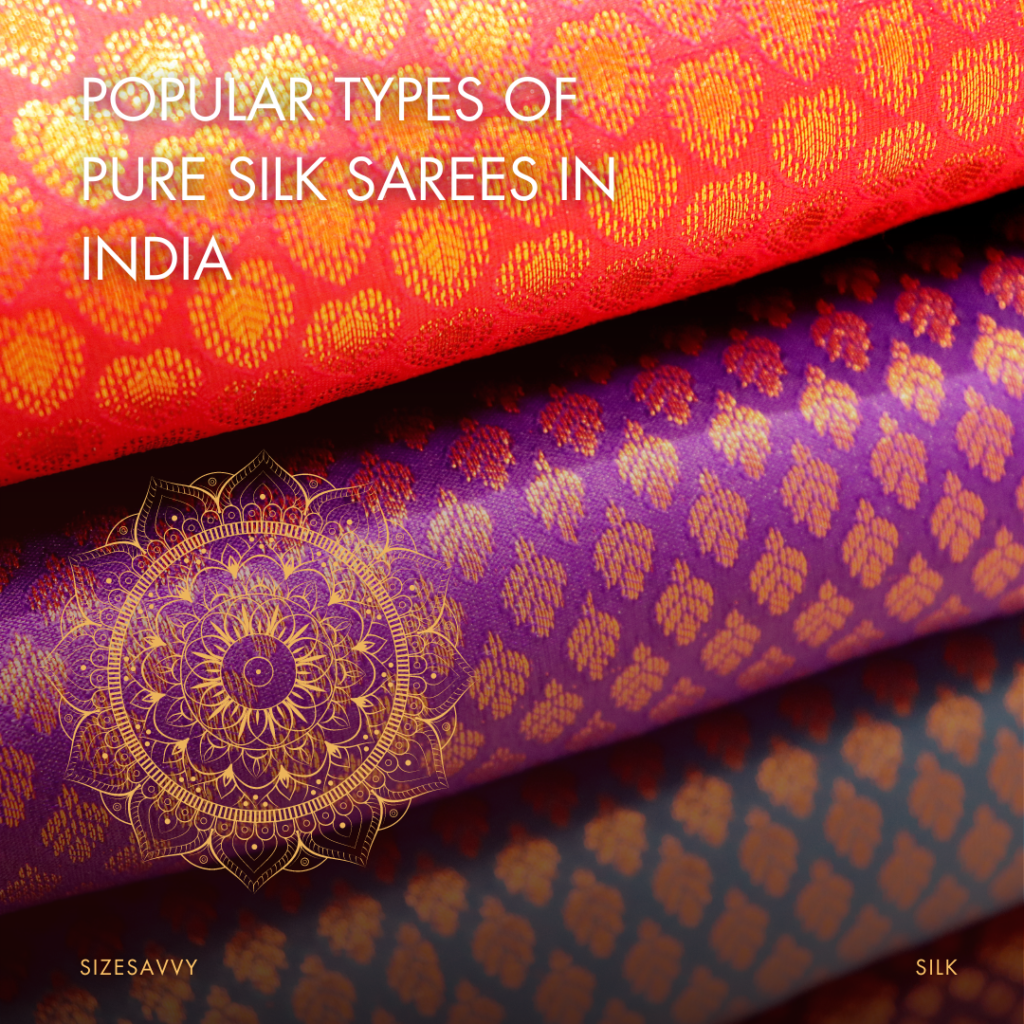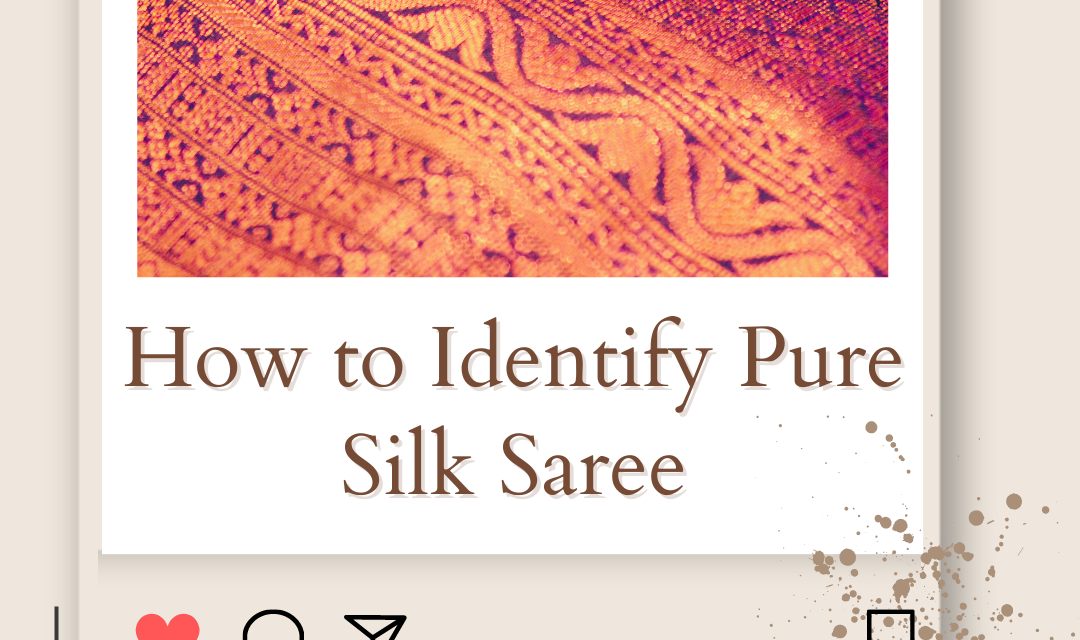How to Identify Pure Silk Saree? Silk sarees are revered for their timeless elegance and luxurious feel, making them a prized possession for women across the globe. However, in a market flooded with imitation products, distinguishing between genuine pure silk and synthetic fabrics can be a daunting task.
This guide will equip you with the essential tips and insights to confidently identify a pure silk saree and ensure you get what you pay for.
Note: make sure to measure your saree size before making any silk saree purchase, Always opt for the Branded saree and branded blouse option for the perfect silk saree outfit.
What is a Pure Silk Saree? Pure silk is a masterpiece crafted from natural silk fibers, obtained from silkworm cocoons. It is known for its luxurious sheen, soft texture, and exquisite drape. Unlike synthetic fabrics, pure silk is a natural and eco-friendly material, making it highly coveted.
Why Identifying Pure Silk is Crucial? Distinguishing between pure silk and synthetic alternatives is vital for ensuring you get authentic products and supporting ethical and sustainable practices. While synthetic sarees may mimic the appearance of silk, they lack its inherent qualities and charm.
How to Identify Pure Silk Saree?
| Silk Features | Points To Consider |
|---|---|
| Silk Texture | Genuine silk has a unique and smooth texture that feels soft to the touch. |
| Silk Shine | Authentic silk has a natural shine that is not overly glossy. |
| Silk Weave Patterns | Look for intricate and well-defined weave patterns on the saree. |
| Silk Zari Work | In genuine silk sarees, zari work (metallic thread embroidery) is intricately woven into the fabric. |
| Silk Mark Label | Check for the Silk Mark label issued by the Silk Mark Organization of India. |
| Price | Real silk sarees are generally more expensive than synthetic ones. |
| Burn Test | Conduct a burn test by taking a few threads from the saree and burning them. |
| Expert Opinion | Seek the advice of experienced silk traders or experts who can identify genuine silk. |
Look for the Silk Mark Label
The Silk Mark label, introduced by the Central Silk Board of India, certifies the authenticity of silk products. Ensure the saree bears this label, assuring you of its pure silk origin.
Check the Silk Texture
Pure silk boasts a soft and smooth texture with a natural sheen. Run your fingers over the fabric to feel its softness, avoiding stiff or rough textures that may indicate synthetic blends.
Examine the Silk Weave Patterns
Familiarize yourself with the distinct weaving techniques of sarees like Banarasi, Kanchipuram, and Mysore silk. Unique weave patterns are indicative of authentic silk.
Perform the Silk Burn Test
Take a few loose threads from the saree and burn them. Pure silk threads will burn slowly, emitting a scent similar to burning hair, while synthetic fabrics will burn quickly, producing a plastic smell.
Feel the Silk Weight and Drape
Authentic silk sarees are generally heavier due to the density of silk fibers. When draped, they flow gracefully and hold their shape impeccably.
Analyze the Silk Zari Work
Genuine silk sarees are often adorned with intricate zari work made of gold or silver threads. Real zari will have a metallic feel and retain its luster even after extended use.
Consider Silk Price and Silk Brand Reputation
Be wary of sarees with unusually low prices, as pure silk is a precious material. Trust reputable brands and sellers known for their genuine silk products.

Popular Types of Pure Silk Sarees
| Silk Saree Types | Saree Features | Price Range (Approx.) | Origin |
|---|---|---|---|
| Kanchipuram Silk | Rich and heavy silk with intricate zari work; vibrant colors; traditional designs | ₹10,000 – ₹50,000 | Kanchipuram, Tamil Nadu |
| Banarasi Silk | Luxurious silk with opulent gold and silver zari work; detailed floral or Mughal-inspired patterns | ₹5,000 – ₹1,00,000 | Varanasi, Uttar Pradesh |
| Patola Silk | Double Ikat weave with geometric patterns; vibrant and contrasting colors | ₹20,000 – ₹2,00,000 | Patan, Gujarat |
| Mysore Silk | Soft and lightweight silk; minimalistic and elegant designs; known for its simplicity | ₹3,000 – ₹15,000 | Mysore, Karnataka |
| Baluchari Silk | Detailed woven pallu depicting mythological stories; intricate and artistic designs | ₹10,000 – ₹40,000 | Murshidabad, West Bengal |
| Tussar Silk | Coarse texture with a natural gold sheen; earthy and rustic colors; suitable for both traditional and contemporary wear | ₹3,000 – ₹20,000 | Jharkhand, Bihar, West Bengal |
| Bhagalpuri Silk Saree | Known for its unique texture and resilience; available in various colors and designs | ₹2,000 – ₹10,000 | Bhagalpur, Bihar |
| Chanderi Silk | Lightweight and sheer texture; traditional motifs with gold and silver zari work | ₹5,000 – ₹25,000 | Chanderi, Madhya Pradesh |
| Dharmavaram Silk | Heavy silk with broad borders and contrasting colors; traditional designs with peacock and temple motifs | ₹8,000 – ₹30,000 | Dharmavaram, Andhra Pradesh |
| Kanjeevaram Silk | Rich silk with temple borders and figurative patterns; wide range of colors and designs | ₹5,000 – ₹1,00,000 | Kanchipuram, Tamil Nadu |
| Uppada Silk | Lightweight silk with jamdani technique; delicate and intricate designs | ₹5,000 – ₹20,000 | Uppada, Andhra Pradesh |
| Paithani Silk | Artistic silk with kaleidoscopic borders; peacock and lotus motifs; vibrant colors | ₹15,000 – ₹1,00,000 | Aurangabad, Maharashtra |
Please Note: Price may vary
Caring for Pure Silk Sarees To maintain the beauty and longevity of pure silk sarees, follow the care instructions provided by the manufacturer. do a mild wash with Saree Detergents & Avoid exposing the saree to direct sunlight for extended periods and store it in a cool, dry place.
Conclusion: Embrace the timeless allure of pure silk by mastering the art of identifying authentic products. Armed with the tips and knowledge shared in this guide, you can confidently invest in genuine silk that exudes elegance and grace, adding a touch of opulence to your wardrobe.
Check out the Video On Silk Saree
FAQs on Pure Silk Sarees
How can you tell if silk is real?
Genuine silk has a distinctly soft and smooth texture with a natural sheen. You can also perform a burn test by taking a few loose threads and burning them. Pure silk threads will burn slowly and emit a scent similar to burning hair.
What is the best way to identify silk?
The best way to identify silk is by looking for the Silk Mark label, which certifies the authenticity of silk products. Additionally, you can feel the fabric’s softness, examine the weave patterns, and check for intricate zari work.
How can you tell the difference between pure silk and artificial silk?
Pure silk is made from natural fibers obtained from silkworm cocoons, while artificial silk, also known as synthetic or faux silk, is made from polyester or rayon. Synthetic silk lacks the softness, sheen, and luxurious feel of genuine silk.
How to check the purity of the Kanjivaram silk saree?
To check the purity of a Kanjivaram silk, look for the Silk Mark label, which authenticates silk products in India. Examine the weave patterns, feel the texture, and inspect the zari work, as pure Kanjivaram silk is renowned for its intricate and beautiful craftsmanship.
Is silk shiny on both sides?
Yes, real silk is naturally shiny on both sides, as it is made from continuous silk fibers. The lustrous sheen is a distinctive characteristic of authentic silk.
What is the price of real silk?
The price of real silk can vary depending on the type of silk, quality, and craftsmanship. Pure silk is a premium fabric, and its price can range from moderately expensive to highly luxurious, depending on the brand and intricacy of the design.
What is the original color of silk?
The original color of silk can vary based on the silk-producing insect and its diet. Silk fibers can be off-white, cream, or light yellow in their natural form.
How to identify a Pattu saree?
Pattu saree is a colloquial term used to describe silk sarees, especially in South India. To identify a Pattu saree, look for the Silk Mark label, check the texture and shine, and observe the traditional weaving patterns and motifs that are characteristic of Pattu sarees.















